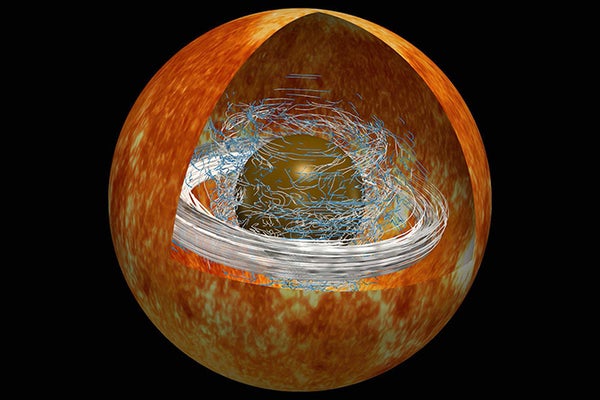When stars are born, their core contracts as they pack in mass. And when stars die, their core shrinks again as they burn off their fuel and begin to collapse into a white dwarf, a neutron star or even a black hole in a supernova explosion. In both cases, the diminishing core starts spinning faster, much like an ice skater does when pulling in their arms.
But observations of stars have revealed something odd: these shrinking stellar cores don’t speed up nearly as much as they should. For example, in a red giants—the kind of star our own sun will eventually become as it ages—the core completes a rotation over the course of up to tens of days, whereas physics would predict it should rotate completely within hours.
Something is slowing down these cores. But what? Now a new simulation reveals the likely culprit: magnetic fields sustained by the turbulence deep inside the regions of stars where the energy created by nuclear fusion is transmitted outward. These fields are shielded from view by stars’ exterior. “The mechanism we observe in our stimulation is very deeply buried inside the radiative region, so you wouldn’t see it from the outside,” says Florence Marcotte, a researcher at Côte d’Azur University in France.
On supporting science journalism
If you're enjoying this article, consider supporting our award-winning journalism by subscribing. By purchasing a subscription you are helping to ensure the future of impactful stories about the discoveries and ideas shaping our world today.
Marcotte conducted the research, published on January 19 in the journal Science, with Ludovic Petitdemange of the Paris Observatory and Christophe Gissinger of École Normale Supérieure in France. Previous studies of stellar spin had looked at the fluid dynamics inside stars, including convection, which is the transfer of energy by the sinking of cool, dense materials and the rise of hotter, less dense materials. But these forces weren’t enough to explain the loss of momentum in star cores. Thus, Marcotte says, scientists suspected that magnetic fields inside stars must also play a role, but exactly how they could form and be sustained was a mystery.
Stars are made of a hot, charged gas called plasma. As this plasma flows, the charged particles’ movement can create magnetic fields. Until now, one of the leading hypotheses of stellar slowdown held that the pull of these magnetic fields, amplified by plasma motions, slows the rotation of the star core. Imagine a spinning figure skater being nudged by a partner, their spin slowed by the additional force on them.
Marcotte, Gissinger and Petitdemange focused on the radiative regions of stars—areas where energy is transferred by radiating outward and where there is no convection. In these regions, the role of the magnetic field in stellar slowdown was debated, Marcotte says, because no one had built a proper numerical model of how these magnetic fields could be generated. By modeling plasma flow in these regions in the new study, the researchers found that even here, stars can generate magnetic fields, which then slow the star core’s spin. The process played out in an unexpected way in their simulations: Initially, an orderly plasma flow exponentially strengthened the magnetic fields in these regions. The strengthening fields, in turn, generated their own turbulent flow of stellar material. This chaotic turbulent motion built up each magnetic field even more, which in turn strengthened the turbulence in a self-sustaining loop, Gissinger says. “At some point, the magnetic field becomes so large that it will exert a torque on the internal region of the star, and it will spin down,” he says. Once this pattern is established, the magnetic field and the turbulence continue to sustain each other, Marcotte says, even if the conditions in the star change to be less prone to these chaotic motions.
The new research is important, says Matteo Cantiello, an astrophysicist at the Flatiron Institute in New York City, who was not involved in the study. The sun is currently about 100 times larger than Earth. One day, he says, our home star will collapse to a white dwarf with the same diameter as our planet. Most of the mass of today’s sun will be packed into that smaller space. Without knowing the correct underlying physics, it’s impossible to understand how the sun and other aging stars will evolve.
The new simulation likely fails to capture all the complexity that occurs in real stars, Cantiello says. But if it does a better job of matching actual observations of stars made by telescopes such as the Kepler space telescope than previous models, it will become the new paradigm for stellar physics.
Scientists also hope to probe deeper into the interior lives of stars in the future. A relatively new field called asteroseismology studies the waves detectable on the exteriors of stars to infer what is going on inside. Asteroseismology is already providing more information on the rotation of star cores across their life span, Cantiello says. It may also be possible to one day detect hints of the magnetic fields found in the new simulation. “Very recently,” Marcotte says, “people have started inferring magnetic field measurements for the deep regions of stars. That was not possible before.”
